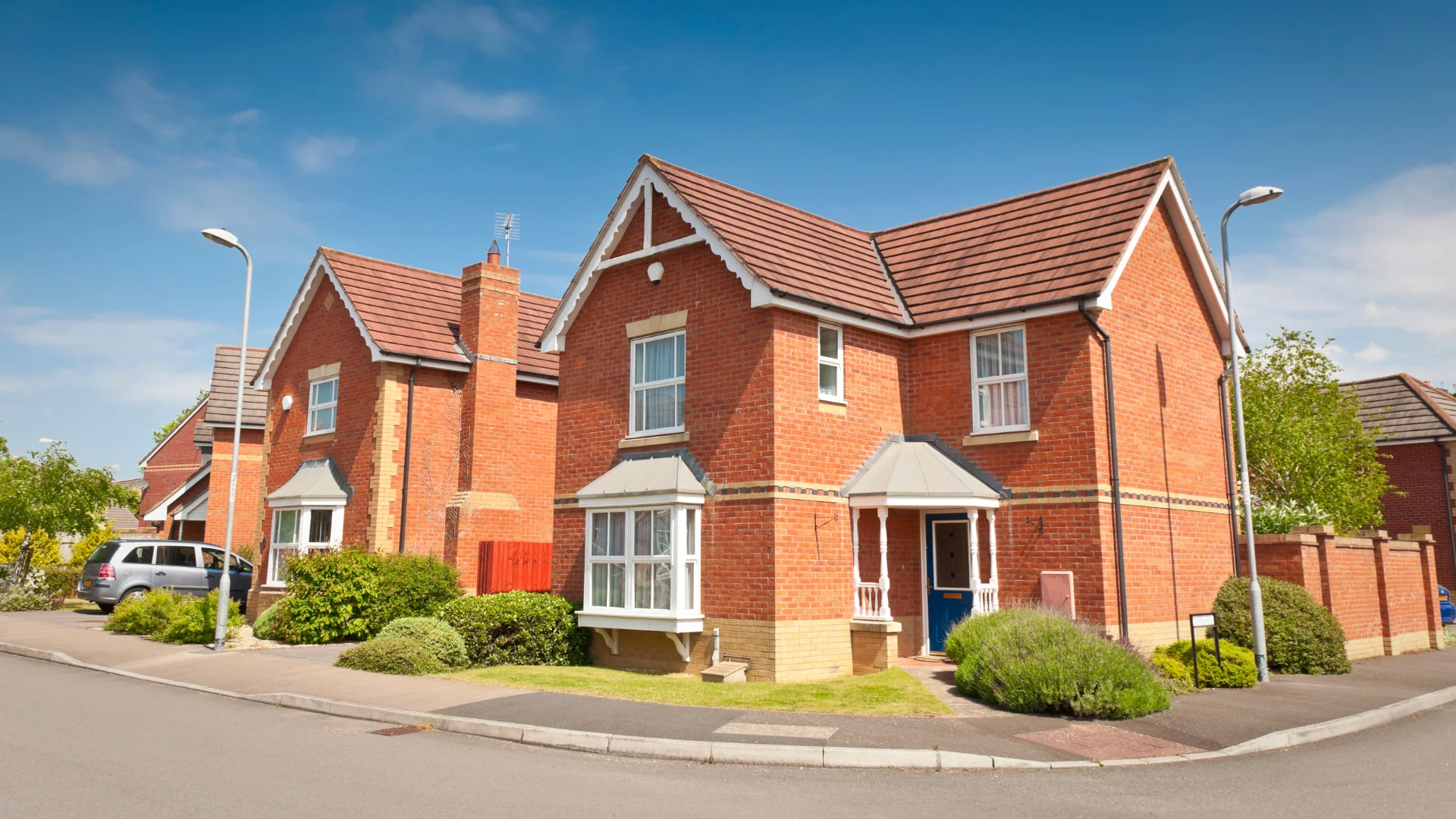- What Are New Build Buy-to-Let Mortgages?
- Are There Buy-To-Let Mortgages Available For New Builds?
- When Is A New Build Buy-To-Let Mortgage A Good Idea?
- How Do New Build Buy-to-Let Mortgages Differ from Other Buy-to-Let Mortgages?
- Eligibility Criteria for New Build Buy-To-Let Mortgages
- Can I Afford It?
- What Are The Rates?
- The Pros And Cons
- Key Takeaways
- The Bottom Line: How To Apply?
New Build Buy To Let Mortgages Explained

A new build property is a brand new home that’s just been built or is still in the construction phase.
Many choose new builds for letting due to their modern design, energy efficiency, and lower maintenance needs. New builds stand out for their fresh feel and often come with the latest home technologies.
When it comes to buy-to-let, new builds are a popular choice. But, getting a mortgage for a new build to let out isn’t the same as the usual buy-to-let mortgage.
The criteria can be quite different.
This guide will shed light on what you need to know about new-build buy-to-let mortgages.
What Are New Build Buy-to-Let Mortgages?
New-build buy-to-let mortgages are loans specifically for buying new-build properties to rent out.
They differ from standard buy-to-let mortgages mainly in the criteria set by lenders. Lenders might see new builds as riskier due to factors like price premiums and unknown rental values.
This means they might ask for a bigger deposit or have stricter rules.
If you’re looking at a new build for your next property investment, understanding these unique mortgage requirements is key.
Are There Buy-To-Let Mortgages Available For New Builds?
Yes, you can find buy-to-let mortgages for new builds, but it’s not always straightforward.
Some lenders might be wary due to certain risks associated with new properties.
For instance, a brand-new property might not fetch the rent you expect, especially if the market dips. New builds often come at a premium price, which might not hold if the market turns.
The lending criteria for these mortgages are quite strict. One reason is the uncertainty around tenant demand for a specific new build.
Also, new properties can face delays in completion, meaning you might miss out on expected rental income.
With older properties, issues like dampness or subsidence are likely already resolved, making them less of a gamble for lenders.
When it comes to new-build flats, the situation gets even trickier. The criteria for buy-to-let mortgages on flats are often more stringent than for houses.
This is mainly due to the leasehold nature of flats, which can come with restrictions and additional costs like ground rent and service charges.
Flats in large developments might also have less appeal due to their location or high maintenance costs, making lenders more cautious.
When Is A New Build Buy-To-Let Mortgage A Good Idea?
A new build buy to let mortgage suits you if:
- You want a modern, low-maintenance property.
- Saving energy bills through high efficiency is important to you.
- Attracting tenants quickly with a new home appeals to you.
- You’re reassured by a 10-year builder’s warranty.
- Extras from developers, like free appliances, are a bonus for you.
- You’re eyeing growth in an up-and-coming area.
- You seek a property ready to rent out without needing fixes.
- You like the idea of being part of a modern community.
- You aim for a property that could grow in value over time.
However, everyone’s situation is different. The best way to determine if this is right for you is by consulting a reputable mortgage advisor. They can provide personalised advice tailored to your unique circumstances and financial goals.
How Do New Build Buy-to-Let Mortgages Differ from Other Buy-to-Let Mortgages?
New build buy-to-let mortgages and traditional buy-to-let mortgages cater to different types of properties, which affects how lenders view them.
Here’s how they differ:
- Deposit Requirements. New build properties often require a higher deposit, sometimes up to 25% or more, compared to older properties.
- Lending Criteria. Lenders might be stricter with new builds due to the perceived risks, such as valuation uncertainties and market fluctuations.
- Interest Rates. You might find that interest rates for new-build buy-to-let mortgages are slightly higher to reflect the increased risk to the lender.
- Rental Yield Assessments. Estimating rental income for new builds can be challenging without comparable data, influencing lender confidence and terms offered.
- Warranty and Guarantees. New builds usually come with a builder’s warranty, which can offer some security but also affect how lenders assess risk.
Fewer lenders offer mortgages for new builds, largely due to the perceived risks.
These include concerns over initial valuation and the potential for depreciation, especially in a volatile market. Additionally, the unknown rental market for new developments can make lenders cautious.
For investors, this means shopping around for a lender that understands and accommodates new build investments, potentially facing higher costs or stricter terms in the process.
Eligibility Criteria for New Build Buy-To-Let Mortgages
Here’s how you can qualify:
- Your expected rental income should typically cover 125%-145% of your mortgage payments.
- Some lenders might require you to have a minimum annual income, often around £25,000.
- Eligibility can depend on whether you’re buying a house or a flat, with flats sometimes facing stricter criteria.
- Most lenders have age limits, usually requiring you to be at least 21 years old.
- A clean credit history is preferred, though some lenders may consider those with minor issues.
- Being an existing landlord might improve your chances, but it’s not always a must.
- The property’s location can influence eligibility, with some lenders favouring certain postcodes or regions.
- For leasehold properties, like most flats, the remaining lease term can be a critical factor, often requiring 85 years or more at the start of the mortgage.
- You’ll likely need at least a 25% deposit for newly built properties.
Can I Afford It?
Wondering if you can afford a buy-to-let property is common. Whether it’s a shiny new build or a characterful old property, the key is understanding your rental yield.
This figure shows how much your potential rental income could cover your expenses.
In the UK, lenders typically look for your rental income to cover at least 125% of your mortgage payments.
To get a ballpark figure, use a rental yield calculator. It’ll give you an estimate to work with.
What Are The Rates?
Rates for new-build buy-to-let mortgages vary. They’re influenced by factors like your deposit size, credit history, and the property’s potential rental income.
Generally, expect slightly higher rates for new builds, as they’re seen as riskier by lenders. That said, several lenders in the UK specialise in or are open to new-build buy-to-let mortgages.
It always pays to shop around or speak to a mortgage advisor who understands the market for the latest deals.
The Pros And Cons
Deciding on a new-build buy-to-let mortgage involves considering both its advantages and challenges. Here’s a straightforward look at the pros and cons:
Pros
- New builds attract tenants quickly, often allowing you to set higher rents.
- Expect lower maintenance and repair costs; no immediate need for major repairs like boiler changes or carpet replacements.
- Benefit from developer incentives, which might include upgraded interiors and appliances, adding value to your property.
- These properties are more energy-efficient, meeting current landlord requirements for Energy Performance Certificates (EPCs) to be an E grade or above.
- Enjoy peace of mind with a 10-year warranty against structural defects.
- Modern safety standards and building regulations enhance property safety and compliance.
Cons
- Higher initial costs can impact your budget due to the premium pricing of new builds.
- Construction delays could postpone your rental plans, affecting income.
- Snagging issues, though usually fixed by developers, could inconvenience you and your tenants in the short term.
- You might face higher mortgage rates as fewer lenders offer new-build buy-to-let mortgages, making your application process more competitive.
- The possibility of depreciation in the early years as the ‘new’ factor diminishes.
- Stricter lending criteria mean you’ll need a solid credit score, a 25% deposit, and sufficient income to secure a mortgage.
- The potential for higher service charges and ground rents, particularly in developments with extensive amenities.
Key Takeaways
- New-build buy-to-let mortgages are made for buying new properties to rent out, but lenders often see them as riskier, so you’ll usually need a bigger deposit and face stricter checks.
- While new builds come with perks like energy efficiency, lower maintenance, and developer incentives, their premium pricing can pose challenges if property values dip.
- Most lenders ask for at least a 25% deposit and want to see that your rental income will comfortably cover 125%-145% of the mortgage payments.
- Flats in big new developments can be harder to finance because of leasehold issues, extra costs like service charges, and doubts about long-term tenant demand.
- Interest rates for new-build buy-to-let mortgages are often a bit higher, but there are lenders out there who specialise in these deals if you shop around.
The Bottom Line: How To Apply?
Before diving in, consider a few things:
- Will the new build attract enough tenants to meet your rental income goals?
- Is the developer reliable, and is the build quality up to scratch?
- Are you financially ready for the mortgage and any unforeseen issues?
If you’re unsure, speaking with a mortgage broker could be beneficial. They can assess rental trends and help estimate your income.
They’ll also advise on suitable deposit amounts and discuss the risks involved with buy-to-let properties, like fluctuating interest rates and vacancy periods.
Brokers might not judge a developer’s reputation, but they know the keys for new build mortgages, such as warranties and developer track records. They’ll highlight the importance of a snagging survey too.
Need a broker? Reach out, and we’ll connect you with a buy-to-let specialist for a free, informal chat to help you find the best mortgage deal.
Get Matched With Your Dream Mortgage Advisor...

Frequently asked questions
What should I know about off-plan property investments?
Buying off-plan means purchasing a property before it’s completed. It’s an attractive option for buy-to-let investors due to potential early value increases.
But, be aware of risks like changes in property valuation and possible construction delays, which could affect your investment timeline.
Can I get a buy-to-let mortgage as a property developer?
Yes, property developers can opt for a build-to-let mortgage, which is designed for those looking to construct or develop properties specifically to rent out.
This type of mortgage considers the future rental income of the completed property as part of the lending criteria.
What is a consumer buy-to-let?
A consumer buy-to-let mortgage is for individuals who become landlords by circumstance rather than choice. This might apply if you’ve inherited a property or moved for work and decided to rent out your former home.




